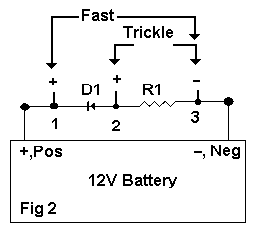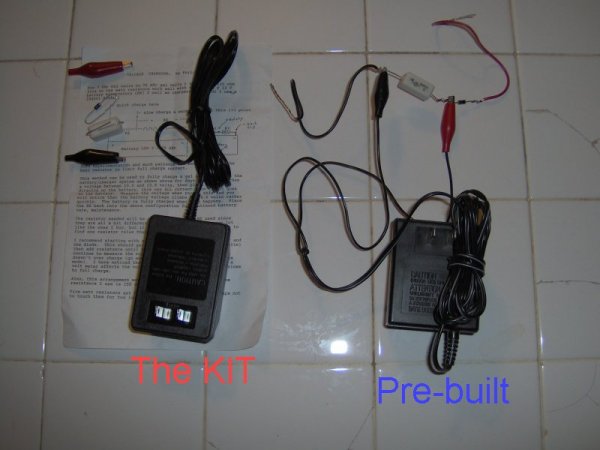TRICKLE CHARGER KIT, by Phil/KE3FL
BUILDING THE TRICKLE CHARGER
NOTE: All WallWarts I now supply are rated: 12V @ 300mA DC so you will
not need to open the case or install any diodes or resistors. You will
still need to install the clips (supplied) (or a plug - not supplied)
on the wires. Be sure to measure the output and mark down which wire is
positive and which is negative. The red clip goes on the positive wire.
Building the trickle charger is very simple. All you need to do is
to cut the plug off the end of the WallWart wires, strip & tin the wires,
measure the voltage to find the correct polarity & then push the
red & black clip covers on the correct wires, solder the alligator
clips to the wires & then pass the covers over the clips. Passing the
covers over the clips is much easier if you first open the clip & attach
it to the other clip in the open position.
Next you need to build the limiting circuit, follow the schematic below
for the correct colors & diode orientation.
Solder one end of the 25 ohm 5W resistor to the black wire supplied
and the other end to the diode as shown below in Figure 2. Solder the
red wire to the other end of the diode. Strip off about 2 inches of
wire cover from both the read & black wires & then solder tin these wires.
These will be easier to connect to the battery this way.
This is the minimal circuit needed for the charger. You can add a
small capacitor between the positive connection and the negative if you
want. If you do that, you should also add a one megaohm resistor
across the capacitor to help discharge it. These are not needed and I
do not recommend them.
MEASUREMENTS
Since the voltage is unfiltered alternating DC, the voltage will
measure low on your DC meter. Don't worry, this is normal. If you
simply add a capacitor to the end of the red and black wires, the
voltage will climb up to about 17 volts. (This is with no load and,
again, is normal.) Once you have checked this out and it all looks
okay, it's time to close the case and put connectors on the ends of the
red and black wires.
RESEALING
I used Methalene Chloride to seal the case together. This is a solvent
which just happens to melt the plastic of this case. Another solvent
which seems to work is the one used on plexiglass-type plastics. You
should be able to get that at any hardware store. Any good plastic glue
should also work. The big advantage of using a solvent is that it
doesn't add anything to the case to hold it together, and I know from
experience that the vise technique used before to open the case will work
again. Glue tends to add stuff to the situation and will need to be
cleaned off if you have to do it again and I don't know how easy it will
be to reopen the case.
THE HOOKUP
You will need to put a plug or clips on the outside ends of the red and
black wires so that they can be connected to the battery to be kept at
full charge. I use Radio Shack part #274-201, the two-pin male
connector I described in my ARES PLUG article. It is all right to use
the male connector in this case since we added the 25 ohm resistor.
This resistor insures the safety and life of the transformer should we
accidentally short out the red and black wires by limiting the current
to 375 ma, which is below the maximum continuous current of 400 ma.
BASIC INFORMATION and THE HOOKUP
To charge a gel cell (12 volt version) it should be allowed to
go up to 14.4V. At that time it is considered (by the
manufacturers, 14.4 - 15 volts) to be fully charged. With a
battery eliminator type charger you may notice that the charge
current continues to drop as the voltage increases. This is a
good thing since you don't want to keep forcing 800 ma into your
battery when it is fully charged anyway.
Smart chargers measure the voltage & reduce the current so that
they keep the battery topped off continually after the battery
reaches full charge. If you measure the voltage at this time
you may notice it changing from time to time as the unit senses
that a bit more current is needed.
Another way to do the same thing is with a resistor/diode
accross the battery. Set the diode so that no current flows
through the resistor when attached to the battery. Then attach
a 12 V battery eliminator (one of which you no doubt have around
the house someplace) accross the resistor. In this way the
eliminator current is split between the battery and the
resistor. Pick the resistor such that its current draw is the
same from the eliminator as the battery's when the battery
reaches 13.8 Volts. With the diode this should be between 13.5
and 13.8 volts on the battery.
For 7 AHr Gel cells to 75 AHr gel cells I found that 125 ohm
five to ten watt resistors work well with the 300 ma @ 12 V
battery eliminators (BE) I sell as chargers. (For D1 I use a
1N4001 diode.)
Connections: Always connect the TCP negative wire to point 3. For
fatser charging connect the TCP positive wire to point 1. For
maintenance charging connect the TCP positive wire to point 2.
 Some experimentation and much patience are needed to find the
best resistor to limit the charge current correctly for a given
battery.
Some experimentation and much patience are needed to find the
best resistor to limit the charge current correctly for a given
battery.
This method can be used to fully charge a gel cell. I leave the
battery/charger system as shown above for days until it reaches
a voltage between 13.5 and 13.8 volts, then place the BE
directly on the battery, this way ALL current from the BE goes
to the battery. Measure the voltage when you do this and you
will notice that the battery voltage climbs to 14.4 volts rather
quickly. The battery is fully charged when this happens. Place
the BE back into the above configuration for continued battery
care, maintenance.
The resistor needed will be different for each BE used since
they are all a bit different, even the ones from the same lot
like the ones I buy, but if you buy a bunch you will be able to
find one resistor value that is good for the majority.
I recommend starting with a 100 ohm five or 10 watt resistor and
the diode. This should get you close (about 13.0 to 13.3 volts)
then add resistance until the battery is fully charged and
continue to measure the voltage for a few days to be sure it
doesn't over charge (go above 13.80 Volts when in maintenance
mode). I have noticed that in this arrangement even adding a
volt meter affects the voltage reading when the battery is close
to full charge.
Also, this arrangement works for lead acid batteries but the
resistance I use is 150 ohms.
Five watt resistors get HOT with the BE's I use so take care not
to touch them for too long a time.
Good-luck and I hope this helps. I am not finished with my
experiments but this is what I have found out so far.
73 de KE3FL/Phil
[Just the Hookup page]

